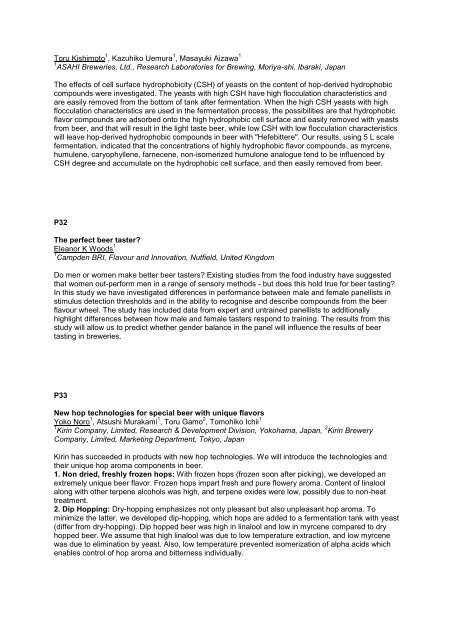here - the 34th European Brewery Convention
here - the 34th European Brewery Convention
here - the 34th European Brewery Convention
You also want an ePaper? Increase the reach of your titles
YUMPU automatically turns print PDFs into web optimized ePapers that Google loves.
Toru Kishimoto 1 , Kazuhiko Uemura 1 , Masayuki Aizawa 1<br />
1 ASAHI Breweries, Ltd., Research Laboratories for Brewing, Moriya-shi, Ibaraki, Japan<br />
The effects of cell surface hydrophobicity (CSH) of yeasts on <strong>the</strong> content of hop-derived hydrophobic<br />
compounds were investigated. The yeasts with high CSH have high flocculation characteristics and<br />
are easily removed from <strong>the</strong> bottom of tank after fermentation. When <strong>the</strong> high CSH yeasts with high<br />
flocculation characteristics are used in <strong>the</strong> fermentation process, <strong>the</strong> possibilities are that hydrophobic<br />
flavor compounds are adsorbed onto <strong>the</strong> high hydrophobic cell surface and easily removed with yeasts<br />
from beer, and that will result in <strong>the</strong> light taste beer, while low CSH with low flocculation characteristics<br />
will leave hop-derived hydrophobic compounds in beer with "Hefebittere". Our results, using 5 L scale<br />
fermentation, indicated that <strong>the</strong> concentrations of highly hydrophobic flavor compounds, as myrcene,<br />
humulene, caryophyllene, farnecene, non-isomerized humulone analogue tend to be influenced by<br />
CSH degree and accumulate on <strong>the</strong> hydrophobic cell surface, and <strong>the</strong>n easily removed from beer.<br />
P32<br />
The perfect beer taster<br />
Eleanor K Woods 1<br />
1 Campden BRI, Flavour and Innovation, Nutfield, United Kingdom<br />
Do men or women make better beer tasters Existing studies from <strong>the</strong> food industry have suggested<br />
that women out-perform men in a range of sensory methods - but does this hold true for beer tasting<br />
In this study we have investigated differences in performance between male and female panellists in<br />
stimulus detection thresholds and in <strong>the</strong> ability to recognise and describe compounds from <strong>the</strong> beer<br />
flavour wheel. The study has included data from expert and untrained panellists to additionally<br />
highlight differences between how male and female tasters respond to training. The results from this<br />
study will allow us to predict whe<strong>the</strong>r gender balance in <strong>the</strong> panel will influence <strong>the</strong> results of beer<br />
tasting in breweries.<br />
P33<br />
New hop technologies for special beer with unique flavors<br />
Yoko Noro 1 , Atsushi Murakami 1 , Toru Gamo 2 , Tomohiko Ichii 1<br />
1 Kirin Company, Limited, Research & Development Division, Yokohama, Japan, 2 Kirin <strong>Brewery</strong><br />
Company, Limited, Marketing Department, Tokyo, Japan<br />
Kirin has succeeded in products with new hop technologies. We will introduce <strong>the</strong> technologies and<br />
<strong>the</strong>ir unique hop aroma components in beer.<br />
1. Non dried, freshly frozen hops: With frozen hops (frozen soon after picking), we developed an<br />
extremely unique beer flavor. Frozen hops impart fresh and pure flowery aroma. Content of linalool<br />
along with o<strong>the</strong>r terpene alcohols was high, and terpene oxides were low, possibly due to non-heat<br />
treatment.<br />
2. Dip Hopping: Dry-hopping emphasizes not only pleasant but also unpleasant hop aroma. To<br />
minimize <strong>the</strong> latter, we developed dip-hopping, which hops are added to a fermentation tank with yeast<br />
(differ from dry-hopping). Dip hopped beer was high in linalool and low in myrcene compared to dry<br />
hopped beer. We assume that high linalool was due to low temperature extraction, and low myrcene<br />
was due to elimination by yeast. Also, low temperature prevented isomerization of alpha acids which<br />
enables control of hop aroma and bitterness individually.





